Fang Zhao
Foundation Model for Skeleton-Based Human Action Understanding
Aug 18, 2025Abstract:Human action understanding serves as a foundational pillar in the field of intelligent motion perception. Skeletons serve as a modality- and device-agnostic representation for human modeling, and skeleton-based action understanding has potential applications in humanoid robot control and interaction. \RED{However, existing works often lack the scalability and generalization required to handle diverse action understanding tasks. There is no skeleton foundation model that can be adapted to a wide range of action understanding tasks}. This paper presents a Unified Skeleton-based Dense Representation Learning (USDRL) framework, which serves as a foundational model for skeleton-based human action understanding. USDRL consists of a Transformer-based Dense Spatio-Temporal Encoder (DSTE), Multi-Grained Feature Decorrelation (MG-FD), and Multi-Perspective Consistency Training (MPCT). The DSTE module adopts two parallel streams to learn temporal dynamic and spatial structure features. The MG-FD module collaboratively performs feature decorrelation across temporal, spatial, and instance domains to reduce dimensional redundancy and enhance information extraction. The MPCT module employs both multi-view and multi-modal self-supervised consistency training. The former enhances the learning of high-level semantics and mitigates the impact of low-level discrepancies, while the latter effectively facilitates the learning of informative multimodal features. We perform extensive experiments on 25 benchmarks across across 9 skeleton-based action understanding tasks, covering coarse prediction, dense prediction, and transferred prediction. Our approach significantly outperforms the current state-of-the-art methods. We hope that this work would broaden the scope of research in skeleton-based action understanding and encourage more attention to dense prediction tasks.
LAD-Reasoner: Tiny Multimodal Models are Good Reasoners for Logical Anomaly Detection
Apr 17, 2025Abstract:Recent advances in industrial anomaly detection have highlighted the need for deeper logical anomaly analysis, where unexpected relationships among objects, counts, and spatial configurations must be identified and explained. Existing approaches often rely on large-scale external reasoning modules or elaborate pipeline designs, hindering practical deployment and interpretability. To address these limitations, we introduce a new task, Reasoning Logical Anomaly Detection (RLAD), which extends traditional anomaly detection by incorporating logical reasoning. We propose a new framework, LAD-Reasoner, a customized tiny multimodal language model built on Qwen2.5-VL 3B. Our approach leverages a two-stage training paradigm that first employs Supervised Fine-Tuning (SFT) for fine-grained visual understanding, followed by Group Relative Policy Optimization (GRPO) to refine logical anomaly detection and enforce coherent, human-readable reasoning. Crucially, reward signals are derived from both the detection accuracy and the structural quality of the outputs, obviating the need for building chain of thought (CoT) reasoning data. Experiments on the MVTec LOCO AD dataset show that LAD-Reasoner, though significantly smaller, matches the performance of Qwen2.5-VL-72B in accuracy and F1 score, and further excels in producing concise and interpretable rationales. This unified design reduces reliance on large models and complex pipelines, while offering transparent and interpretable insights into logical anomaly detection. Code and data will be released.
Deep Learning-Powered Electrical Brain Signals Analysis: Advancing Neurological Diagnostics
Feb 24, 2025Abstract:Neurological disorders represent significant global health challenges, driving the advancement of brain signal analysis methods. Scalp electroencephalography (EEG) and intracranial electroencephalography (iEEG) are widely used to diagnose and monitor neurological conditions. However, dataset heterogeneity and task variations pose challenges in developing robust deep learning solutions. This review systematically examines recent advances in deep learning approaches for EEG/iEEG-based neurological diagnostics, focusing on applications across 7 neurological conditions using 46 datasets. We explore trends in data utilization, model design, and task-specific adaptations, highlighting the importance of pre-trained multi-task models for scalable, generalizable solutions. To advance research, we propose a standardized benchmark for evaluating models across diverse datasets to enhance reproducibility. This survey emphasizes how recent innovations can transform neurological diagnostics and enable the development of intelligent, adaptable healthcare solutions.
AFANet: Adaptive Frequency-Aware Network for Weakly-Supervised Few-Shot Semantic Segmentation
Dec 23, 2024



Abstract:Few-shot learning aims to recognize novel concepts by leveraging prior knowledge learned from a few samples. However, for visually intensive tasks such as few-shot semantic segmentation, pixel-level annotations are time-consuming and costly. Therefore, in this paper, we utilize the more challenging image-level annotations and propose an adaptive frequency-aware network (AFANet) for weakly-supervised few-shot semantic segmentation (WFSS). Specifically, we first propose a cross-granularity frequency-aware module (CFM) that decouples RGB images into high-frequency and low-frequency distributions and further optimizes semantic structural information by realigning them. Unlike most existing WFSS methods using the textual information from the multi-modal language-vision model, e.g., CLIP, in an offline learning manner, we further propose a CLIP-guided spatial-adapter module (CSM), which performs spatial domain adaptive transformation on textual information through online learning, thus providing enriched cross-modal semantic information for CFM. Extensive experiments on the Pascal-5\textsuperscript{i} and COCO-20\textsuperscript{i} datasets demonstrate that AFANet has achieved state-of-the-art performance. The code is available at https://github.com/jarch-ma/AFANet.
Kernel-Aware Graph Prompt Learning for Few-Shot Anomaly Detection
Dec 23, 2024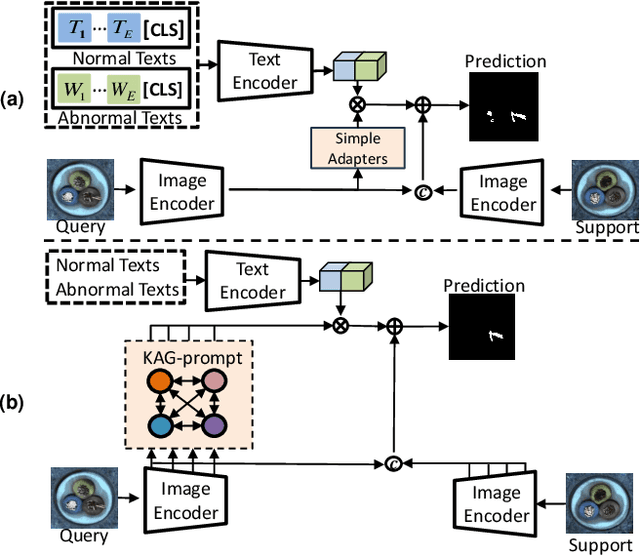
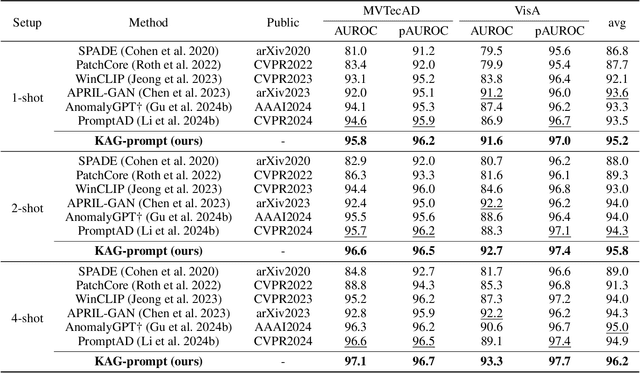
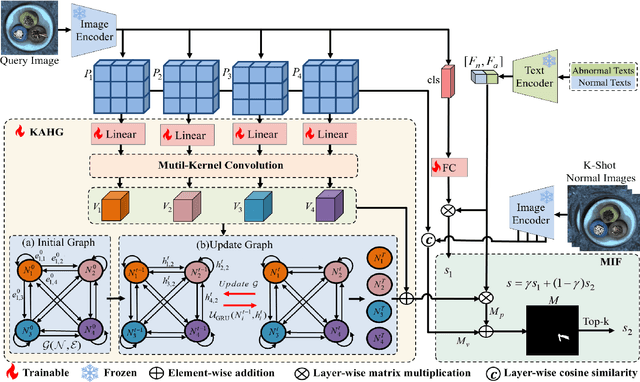

Abstract:Few-shot anomaly detection (FSAD) aims to detect unseen anomaly regions with the guidance of very few normal support images from the same class. Existing FSAD methods usually find anomalies by directly designing complex text prompts to align them with visual features under the prevailing large vision-language model paradigm. However, these methods, almost always, neglect intrinsic contextual information in visual features, e.g., the interaction relationships between different vision layers, which is an important clue for detecting anomalies comprehensively. To this end, we propose a kernel-aware graph prompt learning framework, termed as KAG-prompt, by reasoning the cross-layer relations among visual features for FSAD. Specifically, a kernel-aware hierarchical graph is built by taking the different layer features focusing on anomalous regions of different sizes as nodes, meanwhile, the relationships between arbitrary pairs of nodes stand for the edges of the graph. By message passing over this graph, KAG-prompt can capture cross-layer contextual information, thus leading to more accurate anomaly prediction. Moreover, to integrate the information of multiple important anomaly signals in the prediction map, we propose a novel image-level scoring method based on multi-level information fusion. Extensive experiments on MVTecAD and VisA datasets show that KAG-prompt achieves state-of-the-art FSAD results for image-level/pixel-level anomaly detection. Code is available at https://github.com/CVL-hub/KAG-prompt.git.
Structure-Centric Robust Monocular Depth Estimation via Knowledge Distillation
Oct 09, 2024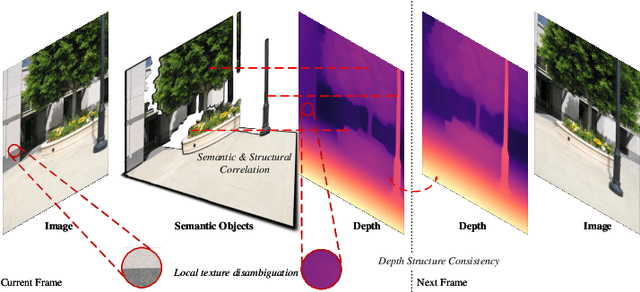
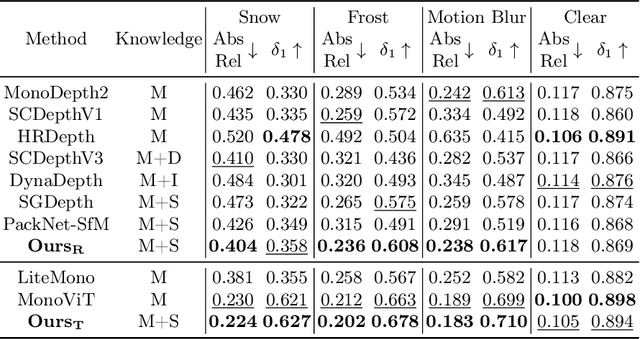
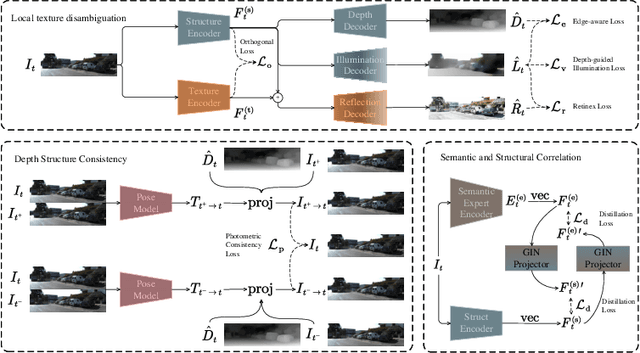
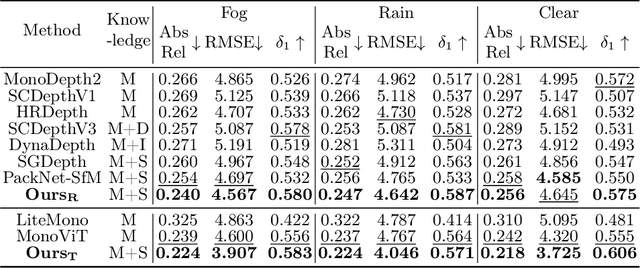
Abstract:Monocular depth estimation, enabled by self-supervised learning, is a key technique for 3D perception in computer vision. However, it faces significant challenges in real-world scenarios, which encompass adverse weather variations, motion blur, as well as scenes with poor lighting conditions at night. Our research reveals that we can divide monocular depth estimation into three sub-problems: depth structure consistency, local texture disambiguation, and semantic-structural correlation. Our approach tackles the non-robustness of existing self-supervised monocular depth estimation models to interference textures by adopting a structure-centered perspective and utilizing the scene structure characteristics demonstrated by semantics and illumination. We devise a novel approach to reduce over-reliance on local textures, enhancing robustness against missing or interfering patterns. Additionally, we incorporate a semantic expert model as the teacher and construct inter-model feature dependencies via learnable isomorphic graphs to enable aggregation of semantic structural knowledge. Our approach achieves state-of-the-art out-of-distribution monocular depth estimation performance across a range of public adverse scenario datasets. It demonstrates notable scalability and compatibility, without necessitating extensive model engineering. This showcases the potential for customizing models for diverse industrial applications.
CSS: Overcoming Pose and Scene Challenges in Crowd-Sourced 3D Gaussian Splatting
Sep 13, 2024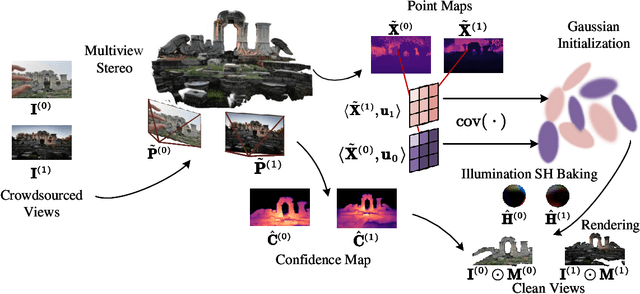
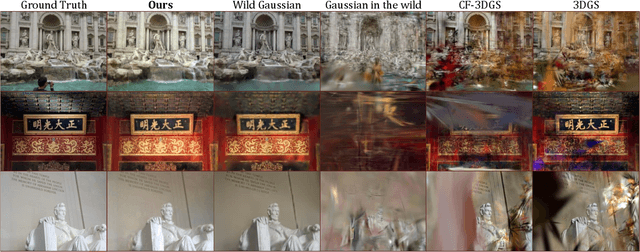

Abstract:We introduce Crowd-Sourced Splatting (CSS), a novel 3D Gaussian Splatting (3DGS) pipeline designed to overcome the challenges of pose-free scene reconstruction using crowd-sourced imagery. The dream of reconstructing historically significant but inaccessible scenes from collections of photographs has long captivated researchers. However, traditional 3D techniques struggle with missing camera poses, limited viewpoints, and inconsistent lighting. CSS addresses these challenges through robust geometric priors and advanced illumination modeling, enabling high-quality novel view synthesis under complex, real-world conditions. Our method demonstrates clear improvements over existing approaches, paving the way for more accurate and flexible applications in AR, VR, and large-scale 3D reconstruction.
Map-Free Visual Relocalization Enhanced by Instance Knowledge and Depth Knowledge
Aug 23, 2024
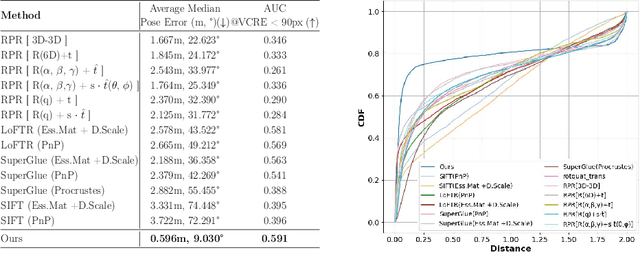
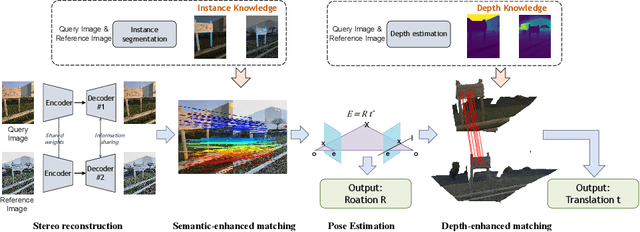

Abstract:Map-free relocalization technology is crucial for applications in autonomous navigation and augmented reality, but relying on pre-built maps is often impractical. It faces significant challenges due to limitations in matching methods and the inherent lack of scale in monocular images. These issues lead to substantial rotational and metric errors and even localization failures in real-world scenarios. Large matching errors significantly impact the overall relocalization process, affecting both rotational and translational accuracy. Due to the inherent limitations of the camera itself, recovering the metric scale from a single image is crucial, as this significantly impacts the translation error. To address these challenges, we propose a map-free relocalization method enhanced by instance knowledge and depth knowledge. By leveraging instance-based matching information to improve global matching results, our method significantly reduces the possibility of mismatching across different objects. The robustness of instance knowledge across the scene helps the feature point matching model focus on relevant regions and enhance matching accuracy. Additionally, we use estimated metric depth from a single image to reduce metric errors and improve scale recovery accuracy. By integrating methods dedicated to mitigating large translational and rotational errors, our approach demonstrates superior performance in map-free relocalization techniques.
OccupancyDETR: Making Semantic Scene Completion as Straightforward as Object Detection
Sep 22, 2023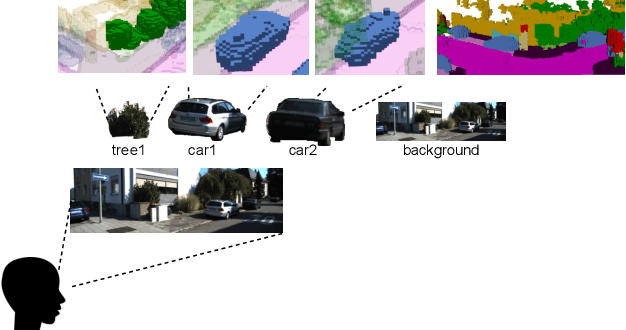

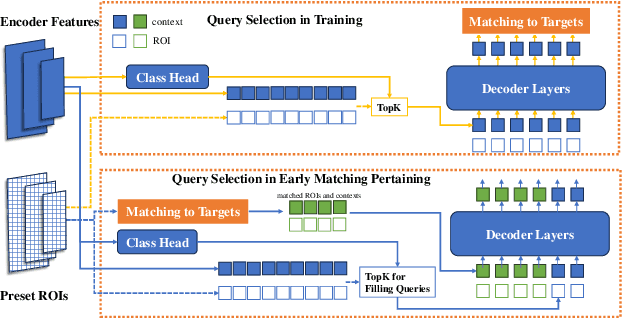
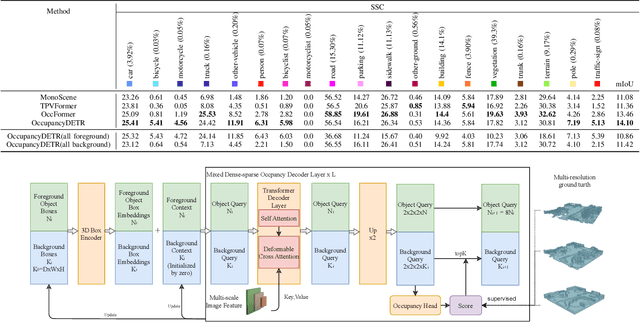
Abstract:Visual-based 3D semantic occupancy perception (also known as 3D semantic scene completion) is a new perception paradigm for robotic applications like autonomous driving. Compared with Bird's Eye View (BEV) perception, it extends the vertical dimension, significantly enhancing the ability of robots to understand their surroundings. However, due to this very reason, the computational demand for current 3D semantic occupancy perception methods generally surpasses that of BEV perception methods and 2D perception methods. We propose a novel 3D semantic occupancy perception method, OccupancyDETR, which consists of a DETR-like object detection module and a 3D occupancy decoder module. The integration of object detection simplifies our method structurally - instead of predicting the semantics of each voxels, it identifies objects in the scene and their respective 3D occupancy grids. This speeds up our method, reduces required resources, and leverages object detection algorithm, giving our approach notable performance on small objects. We demonstrate the effectiveness of our proposed method on the SemanticKITTI dataset, showcasing an mIoU of 23 and a processing speed of 6 frames per second, thereby presenting a promising solution for real-time 3D semantic scene completion.
The RoboDepth Challenge: Methods and Advancements Towards Robust Depth Estimation
Jul 27, 2023



Abstract:Accurate depth estimation under out-of-distribution (OoD) scenarios, such as adverse weather conditions, sensor failure, and noise contamination, is desirable for safety-critical applications. Existing depth estimation systems, however, suffer inevitably from real-world corruptions and perturbations and are struggled to provide reliable depth predictions under such cases. In this paper, we summarize the winning solutions from the RoboDepth Challenge -- an academic competition designed to facilitate and advance robust OoD depth estimation. This challenge was developed based on the newly established KITTI-C and NYUDepth2-C benchmarks. We hosted two stand-alone tracks, with an emphasis on robust self-supervised and robust fully-supervised depth estimation, respectively. Out of more than two hundred participants, nine unique and top-performing solutions have appeared, with novel designs ranging from the following aspects: spatial- and frequency-domain augmentations, masked image modeling, image restoration and super-resolution, adversarial training, diffusion-based noise suppression, vision-language pre-training, learned model ensembling, and hierarchical feature enhancement. Extensive experimental analyses along with insightful observations are drawn to better understand the rationale behind each design. We hope this challenge could lay a solid foundation for future research on robust and reliable depth estimation and beyond. The datasets, competition toolkit, workshop recordings, and source code from the winning teams are publicly available on the challenge website.
 Add to Chrome
Add to Chrome Add to Firefox
Add to Firefox Add to Edge
Add to Edge